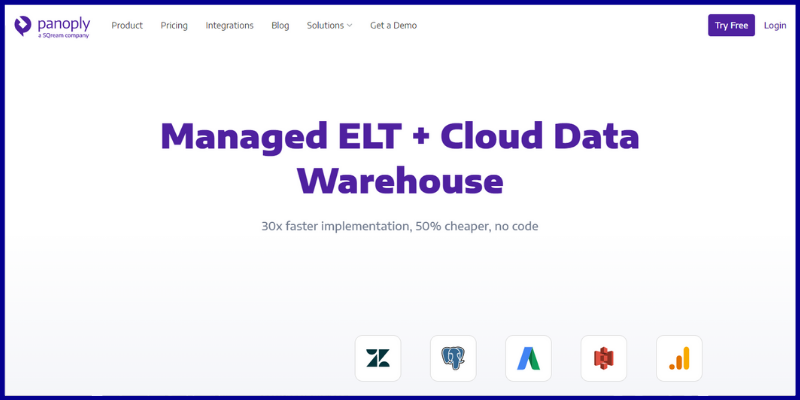What is a snowflake used for?
In simple terms, Snowflake is one of the data warehouse tools that is quite popular, whereas data warehousing software holds on to data from various sources within the company and makes it discoverable, allowing you to quickly locate the data you require for analysis.
It does not have too many limitations when searching for an alternative to it, but still, there may be a few options that are better for snowflakes and help with your data storage.
Interested customers keep comparing competencies in groups like evaluation and contracting, integration and deployment, service and support, and specific product capabilities when evaluating various solutions.
What are the features to consider to select the best snowflake alternative?
- Firstly, it would be best if it had processing speed irrespective of data size.
- Secondly, it is mandatory to have excellent data visualization.
- It is convenient to have a simple set up that is effortless to maintain and easy to use.
- Great Performance Metrics and Management
- Finally, it must have real-time analytics.
#1 Redshift
Redshift is the best snowflake alternative with a petabyte-scale data processing and fully managed data warehouse service delivered via the cloud.
Moreover, users can use Redshift to extend their data warehouse queries to their data lake. It has huge parallel processing, allowing it to deliver the fastest performance.
Also, Redshift works with AWS S3, allowing users to query against the exabytes of data stored in S3 which pushes Redshift to the first place of the list of snowflake alternatives.
Features:
- Data Visualization
- Also, Service Data Preparation is available.
- Visual analytics
- Integration into Third Party Applications
- Finally, it is also an end-to-end encryption.
Pricing:
- Redshift, as a snowflake alternative, has a free version.
- The starter plan starts at $249 and goes up to $999.
- Finally, the business package is totally customized.
#2 Microsoft SQL Server
Microsoft SQL Server is an interpersonal database management system (RDMS) created to aid businesses of all sizes in analysing structured or unstructured data across a variety of data environments such as Azure SQL Database, Azure Cosmos DB, MySQL, and others.
Also, it allows administrators to track database performance, monitor data lakes, and manage data warehousing operations on a single platform.
Features:
- Firstly, it improves your metrics and results by leveraging your data.
- T-SQL support and Azure integration,
- It’s simple to set up, maintain, and use.
- Also, high availability
- Moreover, it has excellent support options with the larger community.
Pricing:
- Moreover, it is totally free, as it is an open-source tool.
#3 PostgreSQL
PostgreSQL is the best alternative to snowflake, which is a relational database management system (RDBMS).
It assists businesses in the storage, management, and scaling of data workflows ranging from single machines to data warehouses to multiple users simultaneously.
Furthermore, PostgreSQL keeps a write-ahead log (WAL), which allows developers to record file changes and restore databases in the event of a system crash.
Administrators can grant permissions to role-based objects as well as column and table level permissions.
Features:
- Access Controls/Permissions
- Configuration Management
- Data Import/Export
- Secure data Storage Management and Synchronization
- Performance Analysis
Pricing:
- Is totally free, as it is an open source tool.
#4 Google BigQuery
Google Bigquery is another great snowflake alternative provided by Google.
There are numerous inputs, such as charges for both long-term and active storage, flat-rate queries, and on-demand queries.
Moreover, this may be overwhelming for new users who lack the necessary experience to accurately forecast consumption rates.
Features:
- ETL – Extract / Transfer / Load
- In-Database Processing
- It combines the serverless architecture
- Real-time analytics.
- Spreadsheet interface.
Pricing:
- Loading, copying, or exporting data; metadata operations are free whereas,
- Storage feature costs $0.02 per GB, per month.
- Streaming inserts costs $0.01 per 200 MB.
#5 Panoply.io

Panoply is a data warehouse as well as an ETL tool. It is the simplest data warehousing solution on the market, combining a secure data warehouse with code-free ETL.
Panoply’s built-in ETL integrations to dozens of data sources are ready to use right away, resulting in quick and easy setup and minimal maintenance.
Users of Panoply can query data directly within the platform or connect to their preferred analytical notebook or business intelligence tool.
Features:
- Data integrations that don’t require any coding
- Connectivity to all of your company’s data, from Amazon S3 to Zendesk
- Also, data does automatic updates.
- SQL for implementing critical business logic
- User permissions for control
- Finally, it is compatibility with analytical.
Pricing:
- Starter package for $399/month for 10 million rows.
- Pro package for $649/month for 100 million rows.
- Expert package for $999/month for 200 million rows.
Conclusion:
My choice and recommendation will be Redshift to have the best full use of all the snowflake alternatives, affordably and to use its features to its whole.
Take time to select the best one. Also, I hope my blog helps you get an idea quickly by looking at each of the best snowflake alternatives for your data.
I found these Best snowflake alternatives out of my own curiosity and hope you will also find them useful in your data maintenance find my ratings right according to their features and limitations.
Share this blog with your friends and follow our PublishSquare for more blogs like this.








